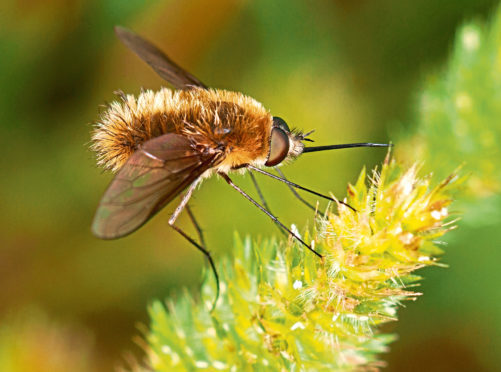Is there such a thing as a cute insect? Well, yes, there most definitely is because I saw one last week – a bee-fly; a little rotund ‘furry’ beast with an impossibly long proboscis.
My garden is a fine place for spotting wildlife – not because it is especially rich in creatures, but more because I spend a lot of my time there, sitting and observing. And thus, so was my bee-fly encounter; one of those unforgettable garden nature moments.
The sun was shining when I noticed this most peculiar looking insect hovering in the air right above my garden chair. It hung for a second or two, then suddenly zipped upwards, before returning to its original hovering station; a process repeated several times. It was the long snout that really stood out, which is used as a probe for sipping nectar, a bit like a hummingbird’s long bill.
They are fascinating creatures and despite their attractive appearance have a rather gruesome life cycle where the female lays her eggs in the nests of solitary bees, wasps and beetles. Or to be more accurate, she flicks her eggs into their burrows. The eggs hatch and the bee-fly larvae crawl further into the nest where they attack the host bee or wasp larvae, feeding upon their bodily fluids and eventually killing them.
There has been other garden action too. A pair of blue tits have taken up residence in one of our next boxes, and the female bird spends a considerable amount of time hammering away at the inside of the box with her beak. Why so, I’m not sure, because you would think the box would be perfect for her requirements, but she obviously doesn’t think so, hence the continual DIY work.
There has also been real drama of the positively violent kind. One morning I awoke to find wood pigeon feathers scattered all over the garden lawn; the remains of a sparrowhawk kill. This female sparrowhawk has a nest in the wood behind our house and she is finding rich pickings for her chicks in this landscape mix of gardens and wild woodland.
But a few days later something remarkable happened. Sitting with my wife in a corner of the garden soaking up the last remnants of evening sun, there was a sudden ‘whoosh’ above our heads, followed by an explosion of twigs. The sparrowhawk had just flown through a hedge while mounting a low-level attack. Not over it, or round it, or even a gently negotiated passage through it, but rather she had blasted a hole into the hedge like a guided missile.
The speed and boldness of the attack underlines just what formidable predators sparrowhawks are. She will also need to be careful in the future because it would have been all too easy to break a wing using such a daring-do tactics. One thing for sure, I reckon my garden birds are going to be in for a torrid time over the next few weeks.
Info
Female sparrowhawks are larger than males and can take birds up to the size of a woodpigeon, whereas males tend to specialise in smaller birds. This size difference enables a pair to make the best use of available food resources.










